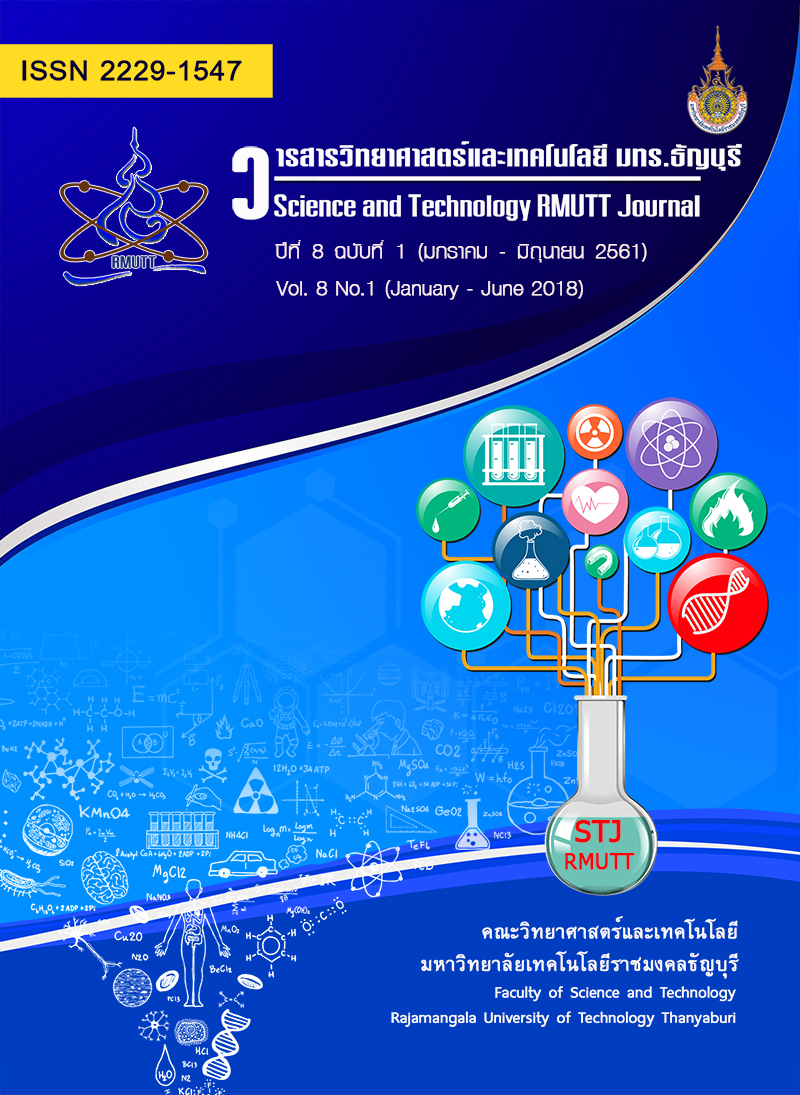Study of Fermented Vinegar from Glutinous Rice Koji
Main Article Content
Abstract
Vinegar is fermented food product. It has been used as food condiment and also beverage. The aim of this study was to study the production of traditional fermented glutinous rice vinegar. Fermentation of glutinous rice vinegar started from rice koji production using 0.1% (w/w) of Aspergillus oryzae L spore, followed by saccharification at 60 °C. After that, alcohol fermentation using 1% (w/w) of Sacharomyces cerevisiae, and acetic acid fermentation using 10% (v/v) of Acetobacter aceti were processed, respectively. There were 3 types of rice used in the experiment, hang glutinous rice, white glutinous rice, and black glutinous rice. The result showed that black glutinous rice showed high potential to use for fermented rice vinegar. Using black glutinous rice showed high amylase activity at 0.821 unit / g dry weight at 3 days of koji production. It also showed the highest total soluble soid at 20 °Brix after 25 h of saccharification and 14% alcohol content after 5 days of alcohol fermentation. Finally, vinegar from black glutinous rice contained 5.16% of acetic acid after 3 days of acetic acid fermentation. However, all of glutinous rice used in this study could be used as raw material of glutinous rice vinegar fermentation because they can provide product quality reach to the standard.
Article Details
References
จารุวรรณ มณีศรี. เทคโนโลยีอาหารหมัก. กรุงเทพ. สำนักพิมพ์โฟเพช. 2551.
สำนักงานมาตรฐานผลิตภัณฑ์อุตสาหกรรม กระทรวงอุตสาหกรรม. มาตรฐานผลิตภัณฑ์ชุมชนน้ำส้มสายชูหมัก. มอก. 326-2547. 2547.
กฤษดา ศิรามพุช. 2552. สรรพคุณข้าวเหนียว. แหล่งที่มา: http://kulc.lib.ku.ac.th/blog/?p=946, 4 กันยายน 2558.
วุฒิพงษ์ ฮามวงศ์. 2557. ข้าวฮาง. แหล่งที่มา: http://natres.skc.rmuti.ac.th/kaowhang.pdf. 3 กันยายน 2558.
Chutmanop J., Chuichulcherm S., Chisti Y. and Srinophakun P. Protease production by Aspergillus oryzae in solid-state fermentation using agroindustrial substrates. J Chem Technol Biotechnol. 2008. 83 : 1012-1018.
AOAC. Official Method of Analysis of AOAC International Volume 2, 17th ed., Association of official chemists, Inc., Arilington, Virginia, U.S.A. 2000.
Chancharoonpong C., Hsieh P.C. and Sheu S.C. Enzyme production and growth of Aspergillus oryzae S on soybean koji fermentation. APCBEE Procedia 2012. 2 : 57-61.
Garcia-Gomez M.J., Ochoa S.H., Corral O.L. and Barragan L.A.P. Advantages of a proteolytic extract by Aspergillus oryzae from fish flour over a commercial proteolytic preparation. Food Chem, 2009. 112 : 604-608.
รวิสรา รื่นไวย์ และ อนุวัฒน์ เตชะฤทธิ์. 2548. การเพิ่มผลผลิตการสังเคราะห์โปรตีนในรา Aspergillus oryzae โดยการควบคุมกิจกรรมของเอนไซม์โปรติเอส. แหล่งที่มา: http://www.kmutt.ac.th/rippc/hetero2.htm. 5 พฤศจิกายน 2558.
ไพบูลย์ ด่านวิรุทัย และพัฒนา เหล่าไพบูลย์. ไวน์ผลไม้และสาโท ผลิตด้วยความมั่นใจได้อย่างไร. ศูนย์วิจัยการหมักเพื่อเพิ่มมูลค่าผลิตภัณฑ์ทางการเกษตรมหาวิทยาลัยขอนแก่น และศูนย์พันธุวิศวกรรมและเทคโนโลยีชีวภาพแห่งชาติ, ขอนแก่น. 2548.
กฤษณา ชุติมา. 2549. โครงสร้างอะไมโลสและอะไมโลเพคติน. แหล่งที่มา: www.biomiami.edu, 14 พฤศจิกายน 2558.
ดุษณี ธนะบริพัฒน์. จุลชีววิทยาอุตสาหกรรม. โครงการตำรา คณะวิทยาศาสตร์ สถาบันเทคโนโลยีพระจอมเกล้าคุณทหารลาดกระบัง. กรุงแทพฯ. 2546.
Yuan D., Rao K., Relue P. and Varanasi S. Fermentation of biomass sugars to ethanol using native industrial yeast strains. Bioresour Technol. 2011. 102 : 3246-3253.
สุมณฑา วัฒนสินธุ์. จุลชีววิทยาทางอาหาร. โรงพิมพ์มหาวิทยาลัยธรรมศาสตร์. กรุงเทพฯ. 2545.


